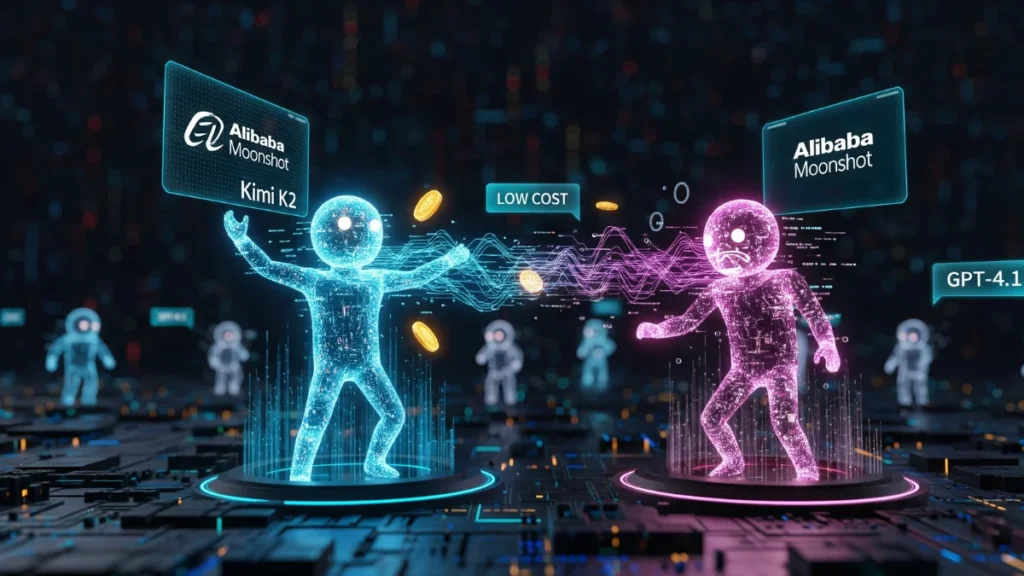A new Chinese AI contender has just landed, and it’s sending ripples through the generative AI landscape. Backed by Alibaba, Moonshot’s latest Kimi K2 model promises better coding chops than OpenAI’s GPT-4.1 — at a fraction of the cost. And it’s open-source. This bold move could reshape the global AI power play.
Key Takeaways
- Kimi K2 claims to outperform OpenAI’s GPT-4.1 and Anthropic’s Claude Opus 4 in coding benchmarks.
- It’s open-source and drastically cheaper to run than its American rivals.
- Coincides with OpenAI delaying its own open-source launch, fueling debate over open access vs. safety.
Late Friday night, Alibaba-backed Moonshot quietly dropped a bombshell in the AI world: its new Kimi K2 large language model. The Chinese startup says Kimi K2 is not only more capable at writing code than top-tier models like Claude Opus 4 and GPT-4.1 — it’s also dramatically more affordable.
This release didn’t just come out of nowhere. It landed at a fascinating moment: just hours after OpenAI CEO Sam Altman confirmed that OpenAI’s first open-source model is postponed indefinitely — again — citing “safety concerns.” That’s not stopping China’s AI startups from pushing the envelope.
What makes Kimi K2 stand out?
It’s open-source, meaning developers can tweak, adapt, and scale the model as they see fit. That alone sets it apart from most American AI releases, which stay firmly behind paywalls and APIs.
Code First, Costs Down
Moonshot says Kimi K2 is laser-focused on generating clean, functional computer code — a holy grail for startups, developers, and big companies hoping to automate workflows or reduce developer costs.
Wei Sun, principal AI analyst at Counterpoint, sums it up: “No doubt Kimi K2 is globally competitive — and it’s open sourced. On top of that, it has lower token costs, making it attractive for large-scale or budget-sensitive deployments.”
Let’s talk numbers:
- Kimi K2 charges just 15 cents per million input tokens and $2.50 for output.
- Compare that to Claude Opus 4 at $15 for input and $75 for output per million tokens.
- OpenAI’s GPT-4.1 sits in the middle, charging $2 for input and $8 for output per million tokens.
It’s easy math: for businesses processing huge volumes of data, Kimi K2 could slash operating costs dramatically.
Unlike ChatGPT and Claude, which require monthly subscriptions for their premium versions, Kimi K2 is free to use through its app and browser interface. For developers, there’s just one catch: if your app gets more than 100 million users or brings in $20 million monthly, you’ll need to show “Kimi K2” in your interface.
Momentum in China’s AI Push
Moonshot isn’t new to the scene. It made waves last year with its chatbot alternative to ChatGPT, gaining a loyal user base in China where ChatGPT is officially blocked. But competition is fierce: ByteDance, Tencent, and Baidu have all jumped in with their own AI assistants. So far, Kimi K2 is earning positive early reviews on both Chinese and English social media, though like every generative AI, it still “hallucinates” — fabricating facts now and then.
One notable fan: Pietro Schirano, founder of MagicPath, called it the first model he feels “comfortable using in production” since Anthropic’s Claude 3.5 Sonnet.
While China’s DeepSeek and Manus AI also made headlines for open-sourcing powerful models, they’ve been relatively quiet lately on major upgrades. Meanwhile, OpenAI’s GPT-5 is reportedly in the works — but no launch date yet.
A Subtle Swipe at OpenAI
Many in the AI community see Moonshot’s timing as no accident. OpenAI’s hesitance to release open-source models leaves an opportunity for Chinese firms to show they’re willing to move fast — and take risks.
Wei Sun believes OpenAI’s push to build GPT-5 might be draining its engineering talent away from any open-source ambitions. There’s also the tricky balance: if OpenAI gives away too much power for free, it risks undercutting its paid flagship product.
One More Thing: A Grok Rival
Moonshot is also eyeing the research frontier. Last month, the company launched a Kimi research model that matched Google’s Gemini Deep Research score and outperformed OpenAI’s version on “Humanity’s Last Exam,” a quirky but telling benchmark. It even came up during Elon Musk’s launch of Grok 4 — xAI’s latest generative AI — showing that Moonshot is chasing multiple targets at once.
Winston Ma, an NYU School of Law professor and AI author, says Kimi-Researcher represents a “paradigm shift” — moving beyond fluent answers to real, autonomous reasoning for more complex tasks.
Conclusion
Moonshot’s latest release makes one thing clear: China’s AI race isn’t slowing down. By betting on open-source and aggressive pricing, the company is putting real pressure on U.S. giants to justify their premium models — and their secrecy.
If Kimi K2 holds up under wider testing, the days of paying a premium just to run AI code might soon be behind us.
